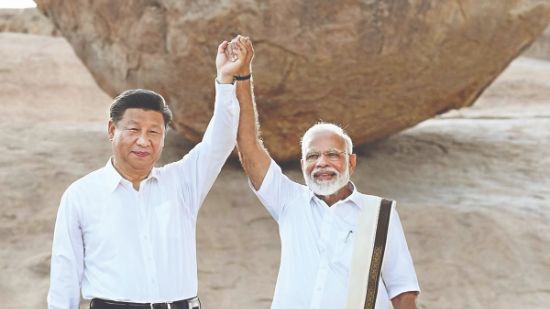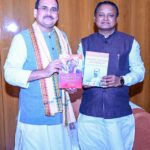Rise of civilisational states
- By : Anirban Ganguly
- Category : Articles

The informal nature of the Mamallapuram summit has allowed Modi and Xi to form connections on shared culture as civilisational states
Much has already been written about the Modi-Xi informal summit in Mamallapuram. The Wuhan Spirit was reciprocated by the Chennai Connect, the significant and symbolic dimension of the meet was its stress on the civilisational connect. Symbolically it was from this part of India, Bharatvarsha, of yore that the Cholas set sail, across the seas and went up to the East Sea and turned the Indian Ocean into the Chola Lake. The mighty land empire of the Cholas had an equally strong maritime circumference. It is well documented that Cholas controlled the Indian Ocean region and the traffic that flowed through the Malacca Strait. Theirs was a sustained, visible, documented presence which has left behind records and expressions both cultural and literary. In that sense, the Indian Ocean has always civilisationally been India’s ocean.
It has been repeatedly established that civilisational India always sought to establish a connect with lands and people that she touched, that her sailors and philosophers, her teachers and merchants all contributed to the enrichment and the prosperity of the people that they came in contact with. Among some of the best descriptions of this interaction are perhaps ones by Dr Raghuvira, intrepid traveller, explorer of civilisational connects, a pre-eminent scholar of India’s civilisational imprints and more mundanely the eighth president of the Bharatiya Jana Sangh.
Describing the phenomenon, Dr Raghuvira wrote, “India has been a perpetual giver of gifts. She did not exploit. She did not dominate with or without arrogance. She did not inflict defeats…Indian missionaries, without the European sword or a book of dogmas in their hands, sallied forth over mountainous crags, over torturous streams, through deserts and snowy peaks, over long distances, occupying not days but months and years and reached the far-off ends of the world, landed among foreign peoples, learnt their languages and becoming one of them, they spread their own fragrance, their own radiance and captivated their hearts and inspired their lives…Work and unselfishness, raising themselves and then raising others, have characterised the work of the Indian missionaries extending over centuries and millenniums…They did not strive for establishing political empires or for robbing other countries of their wealth or their dignity to enrich or heighten their own.”
This movingly and aptly describes the spirit of India’s civilisational connect. It is this same spirit which has defined India’s global outreach, it is this spirit which makes India’s support, her assistance and aid, her partnership, her benign and yet result-oriented camaraderie sought after. She does not intrude, does not seek to create imbalance and instead approaches her commitment through the humanitarian prism. She does not seek to create a false dependence; she rather strives to enhance capacity and potential.
In his indefatigable global outreach, Prime Minister Modi has unceasingly sought to rekindle that connect; he has sought to revivify that spirit of raising others through dignity and association. The holding of the summit in Mamallapuram therefore clearly reflected India’s aspirations to work in that spirit with partners and powers in the region and beyond.
Similarly, Prime Minister Modi’s vision of SAGAR (Security and Growth for All in the Region) for the region, a vision and outreach framework for the Indian Ocean, seeks to not only make India into a net provider of security in the region but to more importantly, revitalise her civilisational linkages in the region, to re-state and re-direct them, so that the area can evolve into a zone of prosperity, stability and opportunity. SAGAR contains in its seed idea a great potential to emerge as a uniting and linking proposition, a grand retracing of past connects as it were.
In the course of the next few years, there ought to be greater progress and movement forward in realising its visions. There needs to be greater deliberation on SAGAR. Invitations ought to be extended to all powers around and in the Indian Ocean region and this needs to be dynamically followed up and enhanced at various levels on a regular basis so that SAGAR becomes an active and viable connecting link and framework. In conceiving and spearheading the narrative of SAGAR, India plays a crucial role and she does this, not in a spirit of hegemony but that of rekindling civilisational connects. It is in this context that the system of informal summits between the two rising powers in Asia, powers which will shape the 21st century as the Asian century becomes significant.
Both India and China are civilisational states with similar characteristics and traits. A leading Chinese public intellectual, Zhang Wei Wei, in his 2011 widely read opus, “The China Wave: Rise of a Civilisational State”, speaks of China as a civilisational state and proffers a detailed description of what he defines as a civilisational state. Wei Wei writes, “A civilisational state has exceedingly strong historical and cultural traditions. It does not easily imitate or follow other models, be they Western or otherwise. It has its intrinsic logic of evolution and development. It is bound to encounter all kinds of challenges in the future, but its rise is seemingly unstoppable and irreversible. The civilisational state has a strong capability to draw on the strengths of other nations while maintaining its own identity. As an endogenous civilisation capable of generating its standards and values, it makes unique contributions to the world civilisations.”
Under this rubric, India also clearly comes across as a civilisational state whose rise is “unstoppable and irreversible.” In India today, there is a comprehensive aspiration towards a national regeneration. India’s “exceedingly strong” and long “historical and cultural traditions” are undeniable and are eliciting a renewed curiosity and attraction worldwide. The rise of two civilisational states has to have the objective of enhancing balance, stability and prosperity. Referring to the civilisational connect between India and China, PM Modi, in his historic speech at the Tsinghua University in May 2015 had said, “the centuries-old story of our relations has been of spiritualism, learning, art and trade. It is a picture of respect for each other’s civilisation and shared prosperity.”
But the rise of civilisational states must also be a rise which is re-assuring and responsible and not be based only on short-term strategic and political calculations. A civilisational state cannot be seen to be generating or siding with elements that are recognised sources of instability, disruption, negativity and stress. A civilisational state rises to counter these to usher in an era of greater equity, stability and responsible partnerships. Civilisational states have to aspire for establishing global roadmaps and not be tied to the politics of elements that have come across as roguish in their dealings with the world.
The rise of two civilisational states must be mutual and be characterised by a constant search for reconnecting civilisational fundamentals. India’s approach at Mamallapuram, her articulation of the Chennai-Connect was an attempt to re-establish those fundamentals. As PM Modi told his young audience at the Tsinghua University in 2015, “If the last century was the age of alliances, this is an era of inter-dependence. So, talks of alliances against one another have no foundation. In any case, we are both ancient civilizations, large and independent nations. Neither of us can be contained nor can we become part of anyone’s plans.” There has to be greater recognition of this and a genuine attempt to rekindle connections based on this essential belief.

















